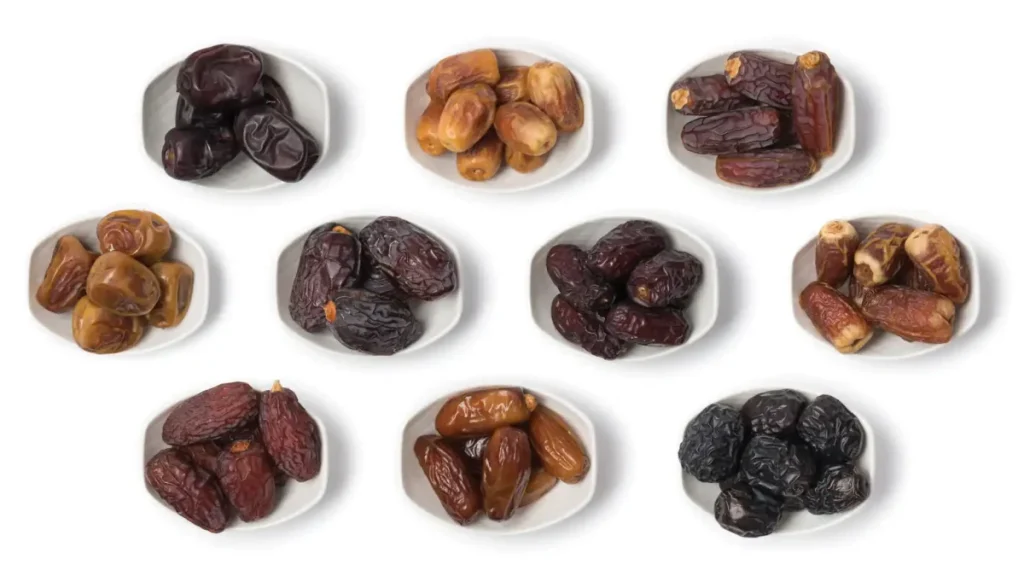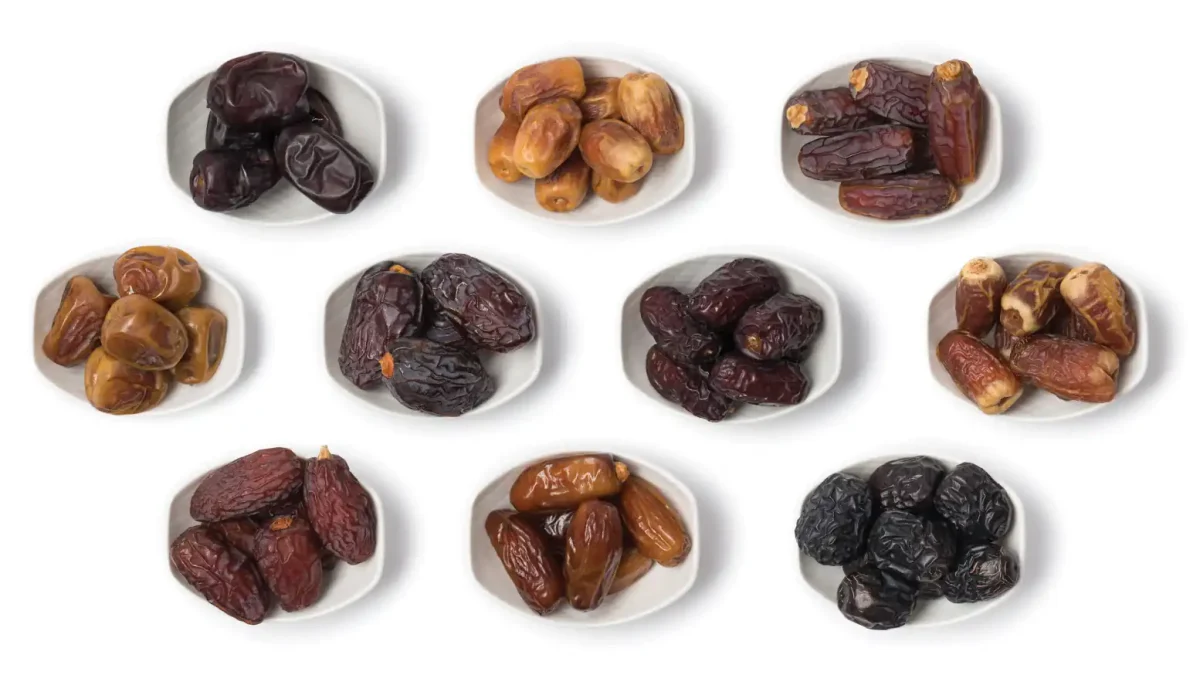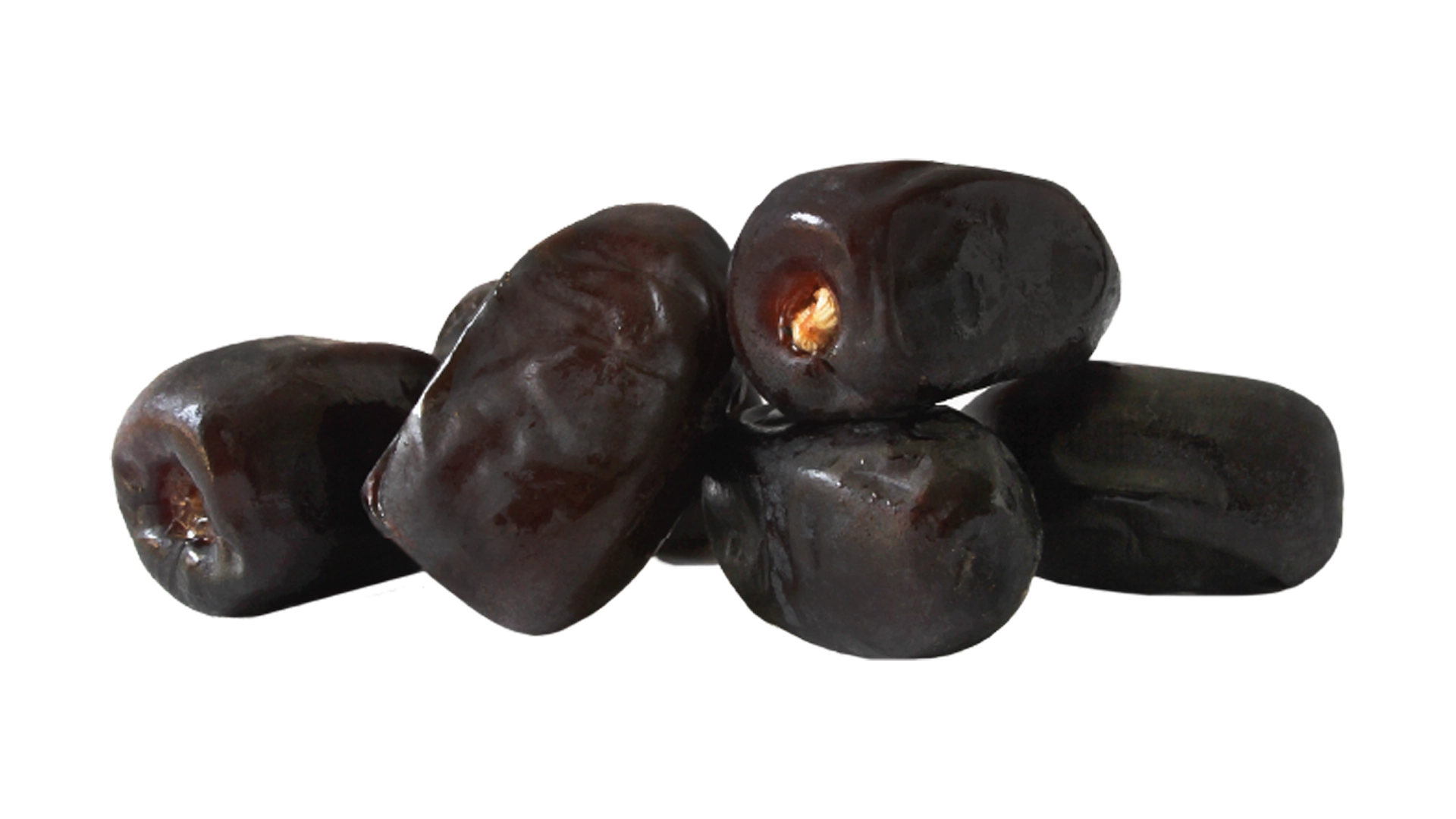Among the 4000 types of dates in the world, 400 types are Iranian dates. These Iranian dates have different tastes, textures, shapes, weights, and colors. In this article, we have provided a comprehensive list of Iranian dates. We have also highlighted their distinct characteristics and origins.
Top 10 Types of Iranian Dates
Let’s take a closer look at the top 10 types of Iranian dates:
- Mazafati/ Kimia / Bam
- Pyarom / Piarom
- Zahedi / Zahidi
- Rabbi
- Lulu
- Sayer
- Kabkab
- Kali / Kaliteh / Kaloute
- Barhi:
- Kharak/ Khalal
- Rotab/Routab
- Khorma
- Khasooii
- Shahani
- Medjool

Mazafati / Kimia / Bam
Mazafati dates originated in Bam city and is one of Iran’s popular date products. They are famous for their delicious smooth skin and meaty texture.
Kimia dates’ shape is oval. Their color is deep brown to black. Bam dates are known for their ability to reduce iron deficiency and anemia. Mazafati is usually half-ripe or partially dried.
For more information about Mazafati dates, read the below:
- The minimum weight of the Mazafati date is 12 grams and the maximum weight is 22 grams.
- The ratio of the Mazafati meat to its seed is about 95%.
- The length of the fruit is at least 3 cm and a maximum of 4.5 cm.
- Its storage conditions are between -5 and +5 degrees Celsius.
- The moisture rate of this date differs based on the ripeness:
- Half-ripe Mazafati dates have 25-30% moisture.
- Partially dried-type humidity is 20-25%.
Pyarom / Piarom
The black or dark Pyarom is a particular type of date in Haji Abad, Hormozgan Province in Iran. It is famous for its unique taste and thin skin. Black Piarom mostly has a higher price than its other type, the Golden Piarom.
On the contrary, the Golden Pyarom is more premium than the Black Pyarom. Piarom types are partially dried and have varying moisture levels. Here, you can read more about Pyarom dates:
- Each date weighs 10-12 grams.
- The size of each Pyarom date approximates 4 to 7 cm.
- The humidity of this type is about 15%.
- They have a high shelf life due to being semi-dry.
- The sweetness of this type of date is less than Routab.
- Their date palms have high resistance to water and soil salinity, temperature changes, etc.
Zahedi / Zahidi
Zahedi dates are mostly cultivated in Bushehr, Lar, and Khuzestan. They have less juice and a soft inner texture with a quite dry outer layer.
These types of dates are light brown and are good for making date vinegar and alcohol. Zahedi’s durability in tropical weather and its long shelf life have made it popular.
If you are interested in knowing more details about this nutritious date, read the items below:
- Each Zahedi date weighs nearly 8 grams.
- The ratio of their meat to their seed is 6.35%.
- Their Average length is 5 cm.
- Since Zahidi is one of the resistant fruits, its transportation is less challenging.
- Zahedi dates are classified as mostly dried dates, while their moisture is approximately 12%.
Rabbi
Rabbi dates originated from Zabol, Iranshahr, and some other cities of Sistan and Baluchestan Province. They have an oval shape. The skin of this date is dark brown, shiny, and transparent, and the size of this date is bigger than the size of other date varieties.
Generally, Rabbi has a semi-dry texture and its mellow sweet taste makes it a favorite among date enthusiasts.
To know more about Rabbi dates, read these items:
- Their minimum weight is 9 grams, and their maximum weight is 12 grams.
- The ratio of their fruit to their seed is about 94%.
- Each Rabbi date is 3 to 5 cm in size.
- The moisture content of the Rabbi is less than 20%
- These dates have a long shelf life.
Lulu
Lulu dates are cultivated in Khuzestan. This type of date is similar to Pyarom in taste.
Lulu is dark brown and has a round appearance similar to plum fruit. The low moisture content places Lulu in the partially dried category of dates. Look at the below items related to Lulu date fruit:
- Each Lulu weighs 6-8 grams.
- The size of each Lulu date is about 1.5 cm.
- The specialists estimated the moisture of Lulu between 10 to 13%.
Sayer / Estamaran
Sayer date can be found in Khuzestan province. These dates are oval and usually reddish brown.
They are popular for their low seed stickiness and high sugar content (above 75%). The semi-dry nature of Sayer dates is the reason for their extended shelf life and ease of export.
If you would like to become more familiar with Sayer date, read the items provided here:
- Their minimum weight is 7 grams, and their maximum is 10 grams.
- The Estamaran fruit-to-seed ratio is 88%.
- The length of each Sayer date is 3.5 to 4 cm.
- The humidity of this type of date is about 18%.
Kabkab
This oval-shaped Kabkab date is one of the semi-dry dates in Iran. Bushehr and Fars provinces are the origin of Kabkab dates. Here are some details about Kabkab dates:
- Their minimum weight is 12 grams and the maximum weight is 15 grams.
- The ratio of Kabkab fruit to its seed is 95%.
- Kabkab dates’ length is 3.5 to 4 cm.
- This date has about 18-20% humidity.
- Kabkab dates can be stored for up to one year if the storage is under the right conditions (minus 5 degrees Celsius).
Kali / Kaliteh / Kaloute
Kali dates are under the category of semi-dry dates in Iran. Kerman Province is the Kaliteh dates source in Iran.
Kaloute is similar to Mazafati. Although, the lower moisture level, sweetness, and dark brown color distinguish it from Mazafati.
More details about Kaloute dates:
- Kali’s minimum weight is 9 grams and its maximum is 11 grams.
- The ratio of Kaliteh fruit to seed is about 90%.
- The length of the date is about 4 to 5 cm.
- Its humidity is 14 to 22%.
Barhi
Barhi date is also cultivated and harvested chiefly in Khuzestan. This type of date is slow ripening and it has excellent resistance to humidity. The small, golden yellow Barhi date has a sweetness that is ripe. However; the sweetness varies as per ripeness.
- The ripeness levels include:
- The yellow and partially ripe stage is referred to as “Khalal,”
- The fully ripe “Routab” stage,
- The dried, wrinkled, and dark brown stage is known as “Tamr.”
Its thick skin and crunchiness make it an excellent choice for both immediate consumption and desserts. Now, let’s learn more about Barhi:
- The weight of each Barhi date is 8-10 grams.
- The ratio of its fruit to seed is about 77.7%.
- This date palm also has larger fruit sizes, which is the reason for differentiating the first and second grades of this product.
Medjool
The Medjool date which is known as the “queen of dates” stands out with its honey-like flavor and soft texture. Medjools are grown in Fars, Kerman, Bushehr, and Khuzestan. Medjool dates are categorized as half-ripe to partially dried dates.
Since the Medjool date is shiny yellow and moist, it is perfect for fresh eating or smoothies, milkshakes, etc. You can find out more information about Medjool:
- Its moisture content ranges between 20-30%.
- Each Medjool date can weigh 8-12 grams.
- This type of date can also grow up to 7 cm long.
| Date Names | Characteristics | Mazafati | Pyarom | Zahedi | Rabbi | Lulu | Sayer | Kabkab | Kaluteh | Barhi | Medjool |
|---|---|---|---|---|---|---|---|---|---|---|
| Color | Dark brown / Black | Black / Golden | Light brown | Half-ripe to partially dried | Dark brown | Reddish brown | Brown | Dark brown | Golden yellow | Shiny yellow |
| Type | Half ripe to partially dried | Partially dried | Partially to mostly dried | Partially dried | Partially dried | Partially dried | Partially dried | Partially dried | Half-ripe to partially dried | Half-ripe to partially dried |
| Texture | Soft | Semi-soft | Soft | Semi-soft | Semi-soft | Soft | Semi-soft | Semi-soft | Soft to semi-soft | Soft to semi-soft |
| Shape | Oval | Oval | Oval | Oval | Round | Oval | Oval | Oval | Round to oval | Oval |
| Weight | 12-22gr | 10-12gr | 6-8 gr | 9-12gr | 6-8gr | 7-10gr | 12-15gr | 9-11gr | 8-10gr | 8-12gr |
| Average Moisture Content | 20-30% | 10-15% | 10-15% | 10-15% | 10-13% | 10-16% | 18-20% | 14-22% | 10-70% | 20-30% |
| Harvest Time | Half-ripe to mostly dried | |||||||||
The date harvesting time varies based on the region. In tropical areas, it starts from August to mid-October. Date harvest in warmer regions occurs earlier, while in colder regions, it is later.
Other types of Iranian dates which are little-known are including
- Ajwa
- Khudri
- Dayri
- Maktoom / Maktoum
There are several lesser-known Iranian date varieties worth exploring. Here, we will discover each.
Ajwa
Ajwa date is grown in some cities such as Khuzestan.
Ajwa dates have a prune-like taste and a soft texture. Their color ranges from dark brown to black. It is classified in the dry dates category.
Khudri
Khudri is grown in Sistan & Baluchestan and Bushehr. Khudri date has a dark brown color with wrinkled skin. The texture is dry, and it has a sweet taste. It’s very valued due to its high quality.
It’s also well-liked for its affordable price. It can be a great option instead of using sugar. Khudri looks smooth and is available in big and medium sizes.
Dayri
Dayri is Originated from Abadan, Khuzestan and Ahvaz. Dayri dates are a kind of semi-dry date fruit. They are large and have an oblong shape. They have thick, soft flesh around a single seed.
The color of Dayri dates is dark brown to black, and they are very juicy. While they might not be as sweet as Medjool dates, some people say they have a better taste.
Maktoom / Maktoum
Maktoom dates are grown in Kerman, Fars and Sistan & Baluchestan. Maktoom date is medium to large-sized fruits. They have a light brown to dark brown color and smooth, glossy, thick fibrous skin.The texture of Maktoom dates is tender and slightly chewy.


